
PARIS AIR SHOWS / LE BOURGET, FRANCE
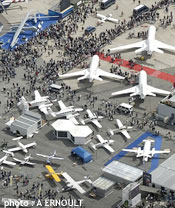
Aerial view of Le Bourget Airport.
Photo: www.ernoult.com




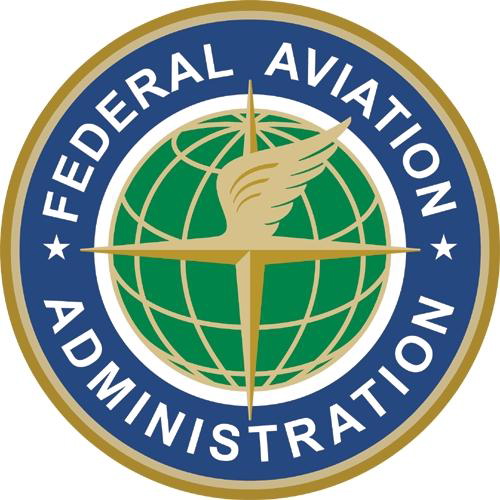

Responsible for the concept, design development, working drawings, specifications, coordination and supervision on site of participating Exhibits for a variety of clients at the biennial Paris Air Show. Also included on-site reception “Chalets” with conference areas for client entertaining, business meetings, seminars and press conferences.
All PAS exhibits were designed in the US and fabricated in Europe. In 1973 a joint venture exhibit for FAA / Raytheon was prepared for the Moscow International Exhibition. Unfortunately, photography was prohibited and is not included.
All PAS exhibits were designed in the US and fabricated in Europe. In 1973 a joint venture exhibit for FAA / Raytheon was prepared for the Moscow International Exhibition. Unfortunately, photography was prohibited and is not included.

Burt Rutan’s PROTEUS after a daily flight
demonstration at the 1999 Paris Air Show.
Scaled Composites was a division of Wyman-Gordon specializing in developing composite materials for aircraft.
demonstration at the 1999 Paris Air Show.
Scaled Composites was a division of Wyman-Gordon specializing in developing composite materials for aircraft.
scroll below to view a synopsis of each exhibit / click on all drawings and sketches to enlarge
1999
Joint participation by Wyman Gordon / Scaled Composites to promote the PROTEUS aircraft and their advances in composite materials.
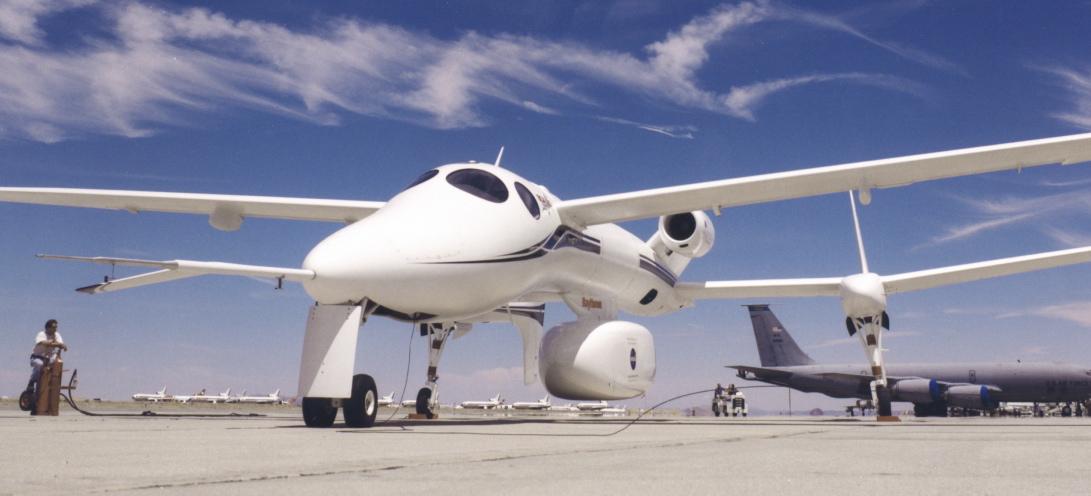
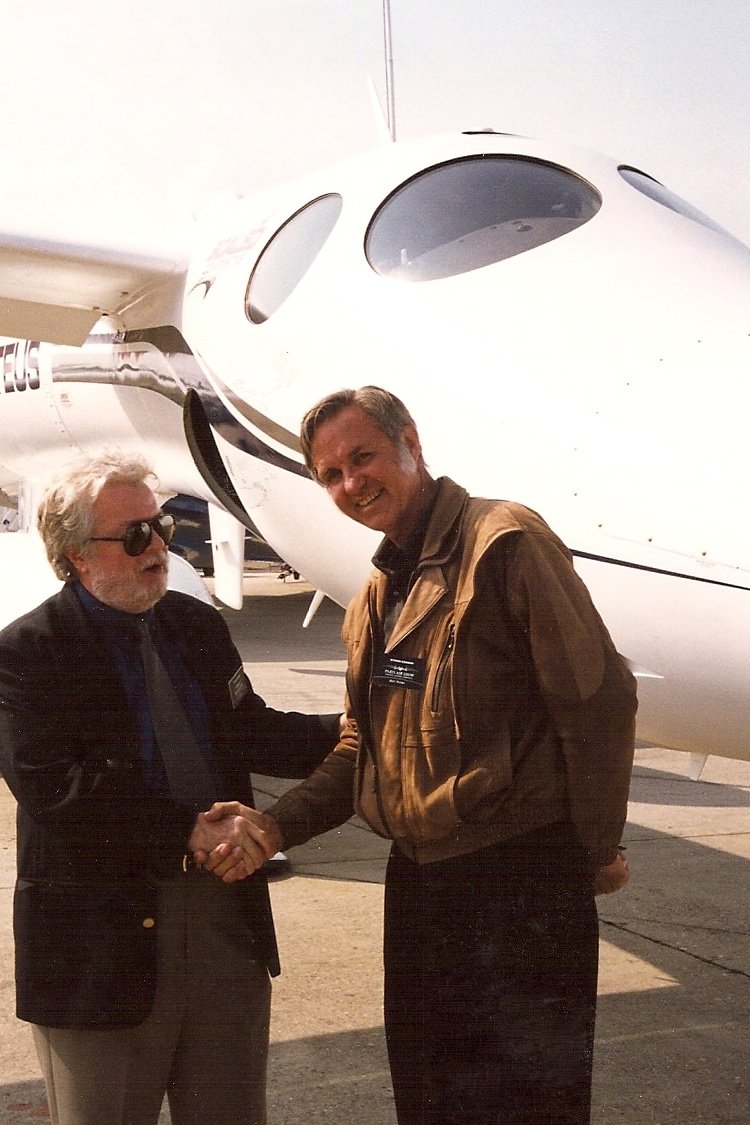
Burt Rutan meets the press.
This was Wyman-Gordon’s initial experience of displaying and demonstrating an aircraft at the Paris Air Show. Daily flights of the PROTEUS and the presence of designer Burt Rutan were a highlight of the show. Scaled Composites' expertise in composite materials for the aircraft industry were featured in the exhibit along with W-G's latest advances in turbine technology. The exhibit site combined exhibit and reception spaces for client meetings, entertaining and press conferences.
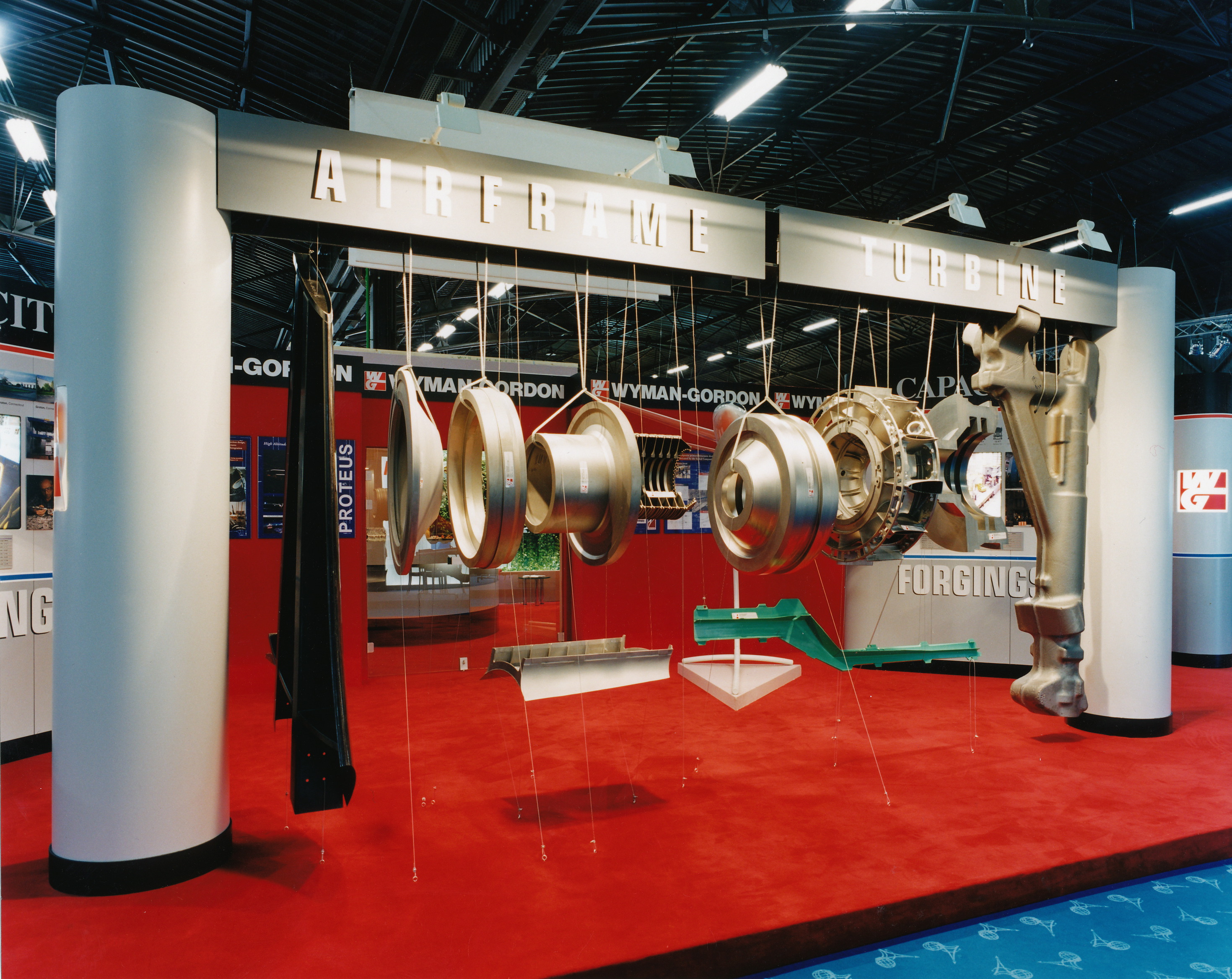
The 2000 sf exhibit in the International Exhibits Hall displaying composites + forgings.
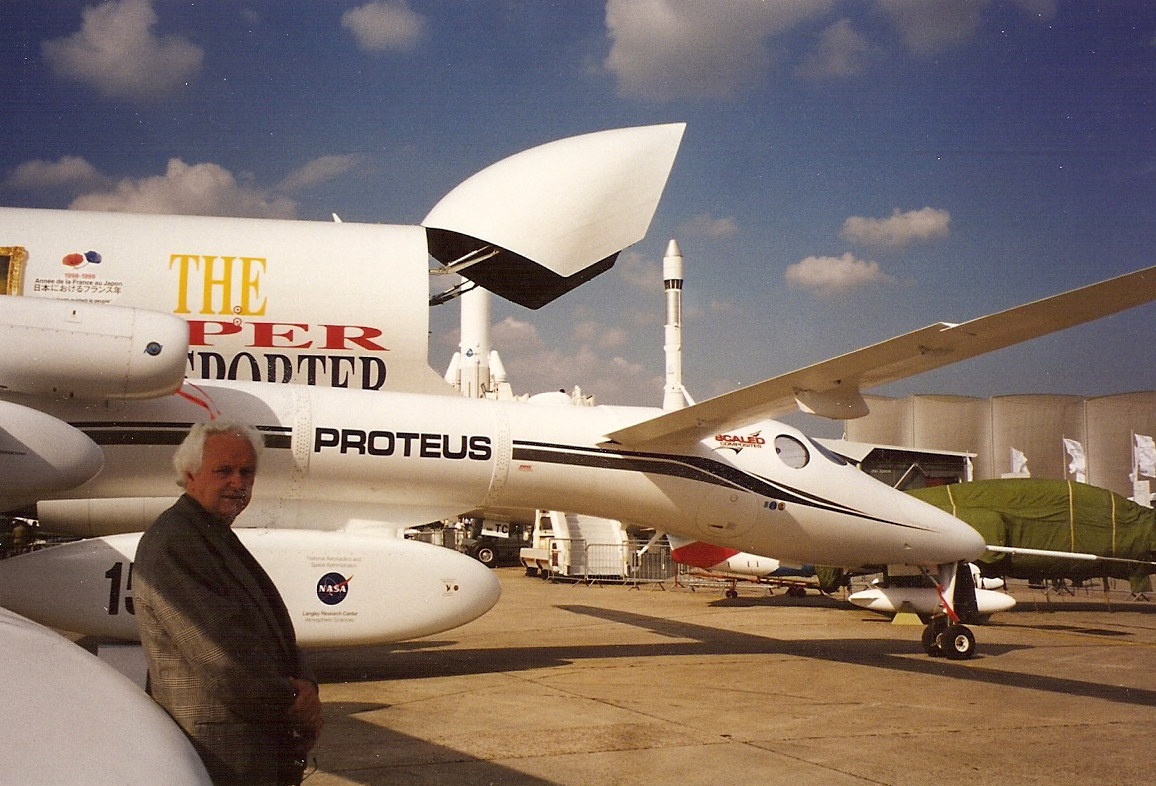
The all-composite PROTEUS on the flight line.
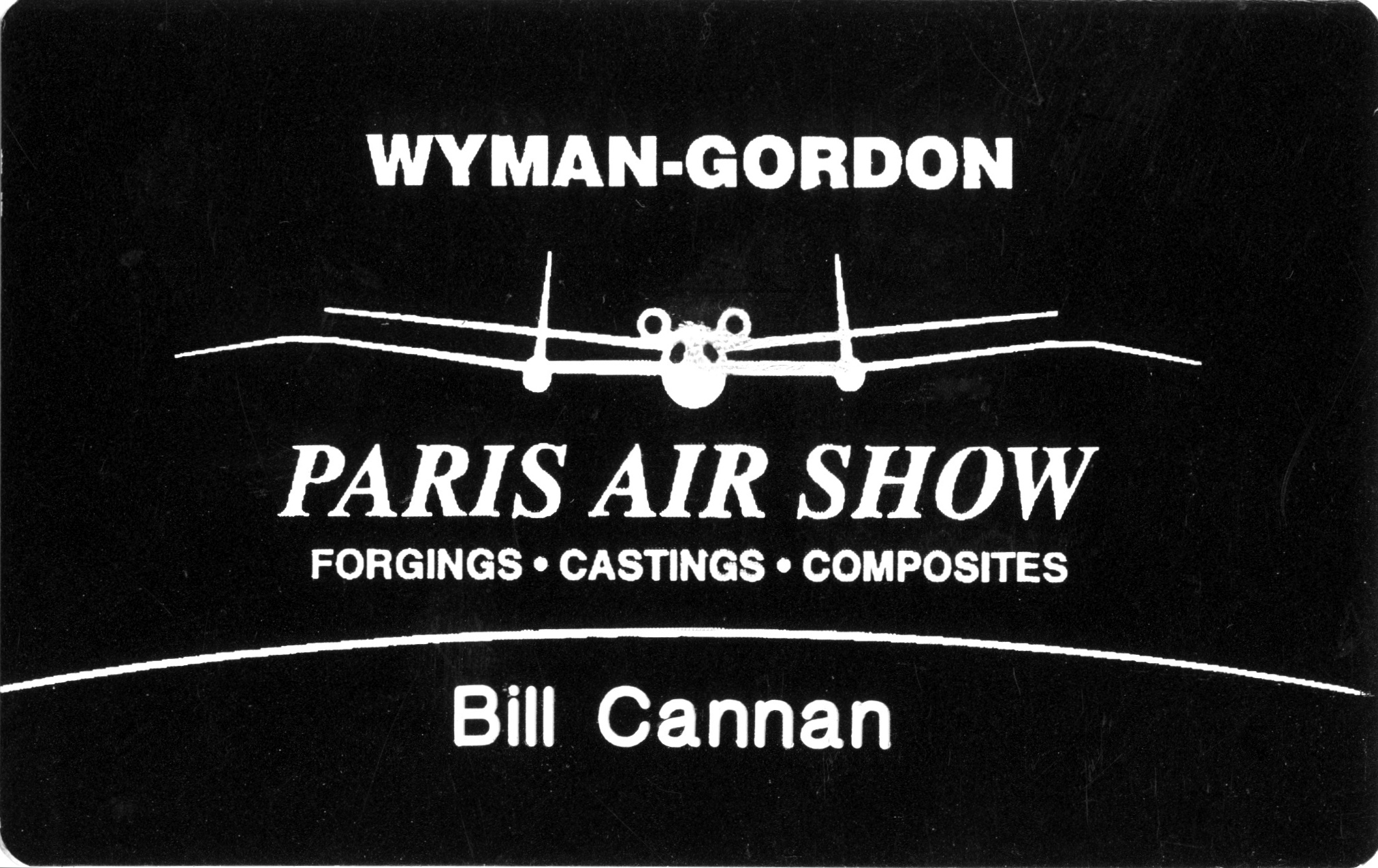
Air Show Badge
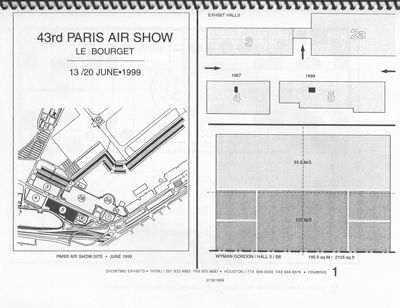
Folios for all WG personnel provided information regarding site location, product data, and general information about the PAS. One section also included recommendations for Paris hotels, restaurant and points of interest.
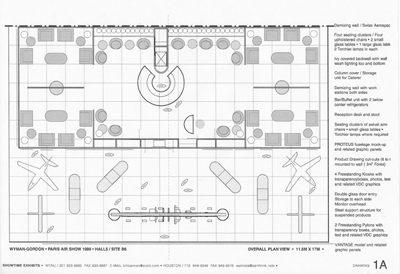
The linear configuration of the space incorporated product display and graphics, reception area, food and beverage service and 4 semi-private meeting rooms.
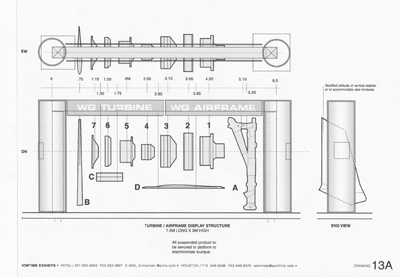
Elevation of exhibit structure with suspended composites, turbine discs and landing gear forging. Four freestanding plyons displayed graphics, charts and statistical data.
WYMAN-GORDON
CHALETS / 1985 - 1987 - 1989 - 1995
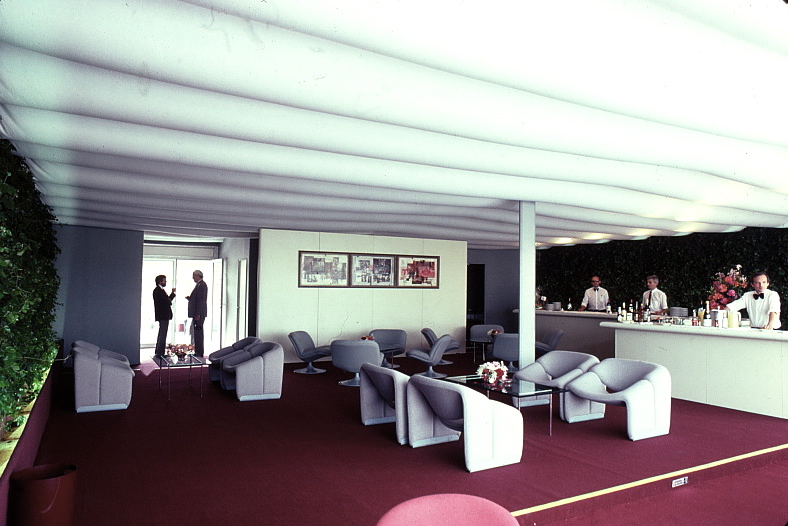
In 1985, WYMAN-GORDON expanded their exhibition participation to include a CHALET on the flight-line at Le Bourget. Opting for a double unit this provided ample space for a reception area for client meetings and entertaining. It also provided a prime viewing area of the runway and flying demonstrations.


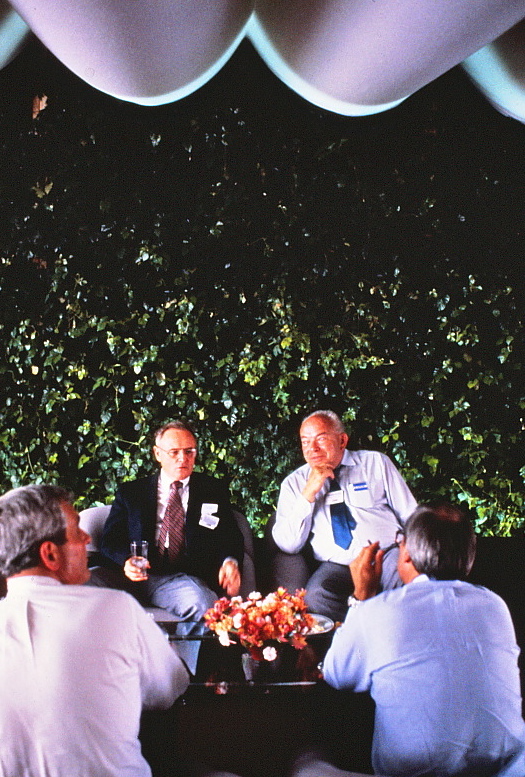
A typical day at the Chalet's
Bar / Buffet reception area.
Bar / Buffet reception area.
Impromptu meetings were common.
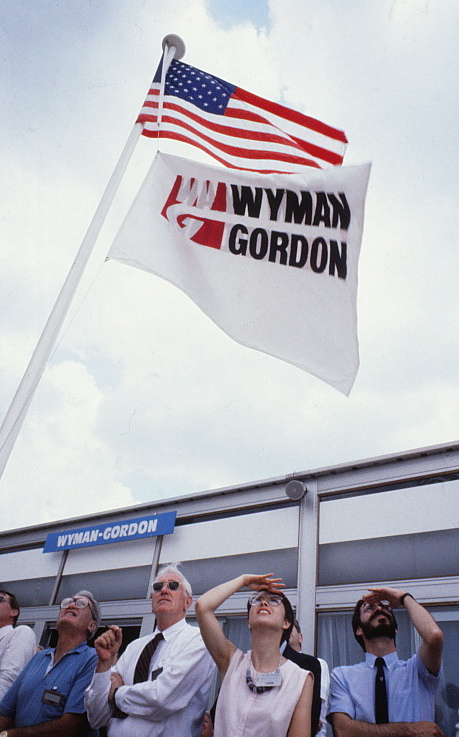
The observation deck offered prime viewing.
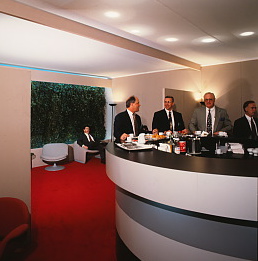

A circular Bar / Buffet variation with ivy wall.
Garden area offered guests
a sit-down dining option.
a sit-down dining option.
The CHALET Design Concept

A presentation model of the Chalet
showing Kitchen, Restroom, Bar / Buffet, Reception area, Outdoor viewing Deck and Garden Patio.
showing Kitchen, Restroom, Bar / Buffet, Reception area, Outdoor viewing Deck and Garden Patio.
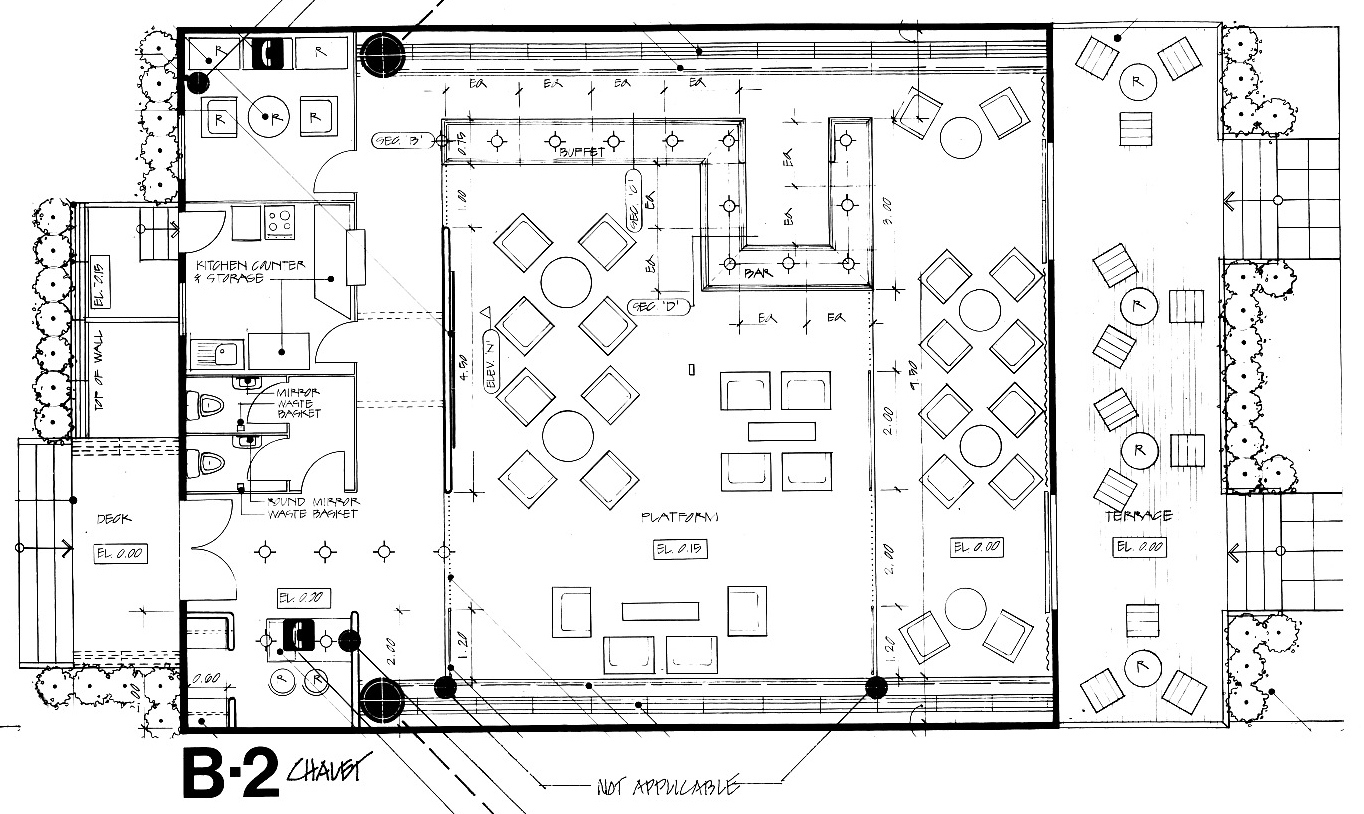
Planning of the Chalet met all rules regarding capacity and safety regulations imposed by the Paris Air Show authorities. The outdoor patio and garden provided a prime viewing area.
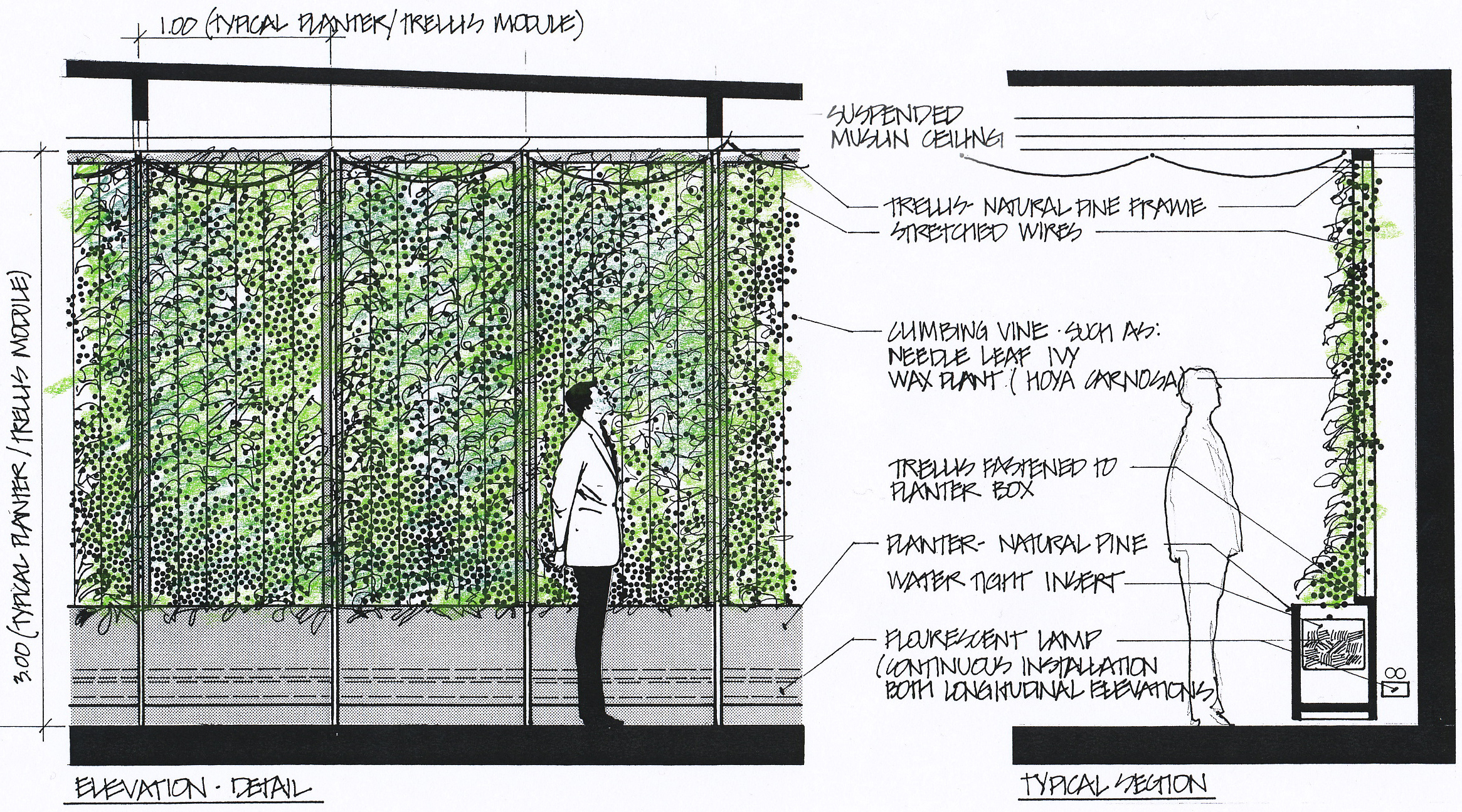
Sketch showing ivy covered walls throughout the Chalet.
Their installation was instrumental in improving air quality and temperature within the double Chalet. A total of 600 potted ivy plants were needed to create the wall.
Their installation was instrumental in improving air quality and temperature within the double Chalet. A total of 600 potted ivy plants were needed to create the wall.
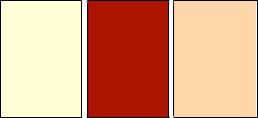
Colors scheme for Bar/Buffet, Carpeting and Walls. Suspended ceiling fabric was white linen with linear lighting behind.

Reception area walls are lined with ivy planters. Other than providing ambiance, they dramatically improved air quality in a confined space. The ivy wall became a featured element in all future Wyman-Gordon Chalets and Exhibits.
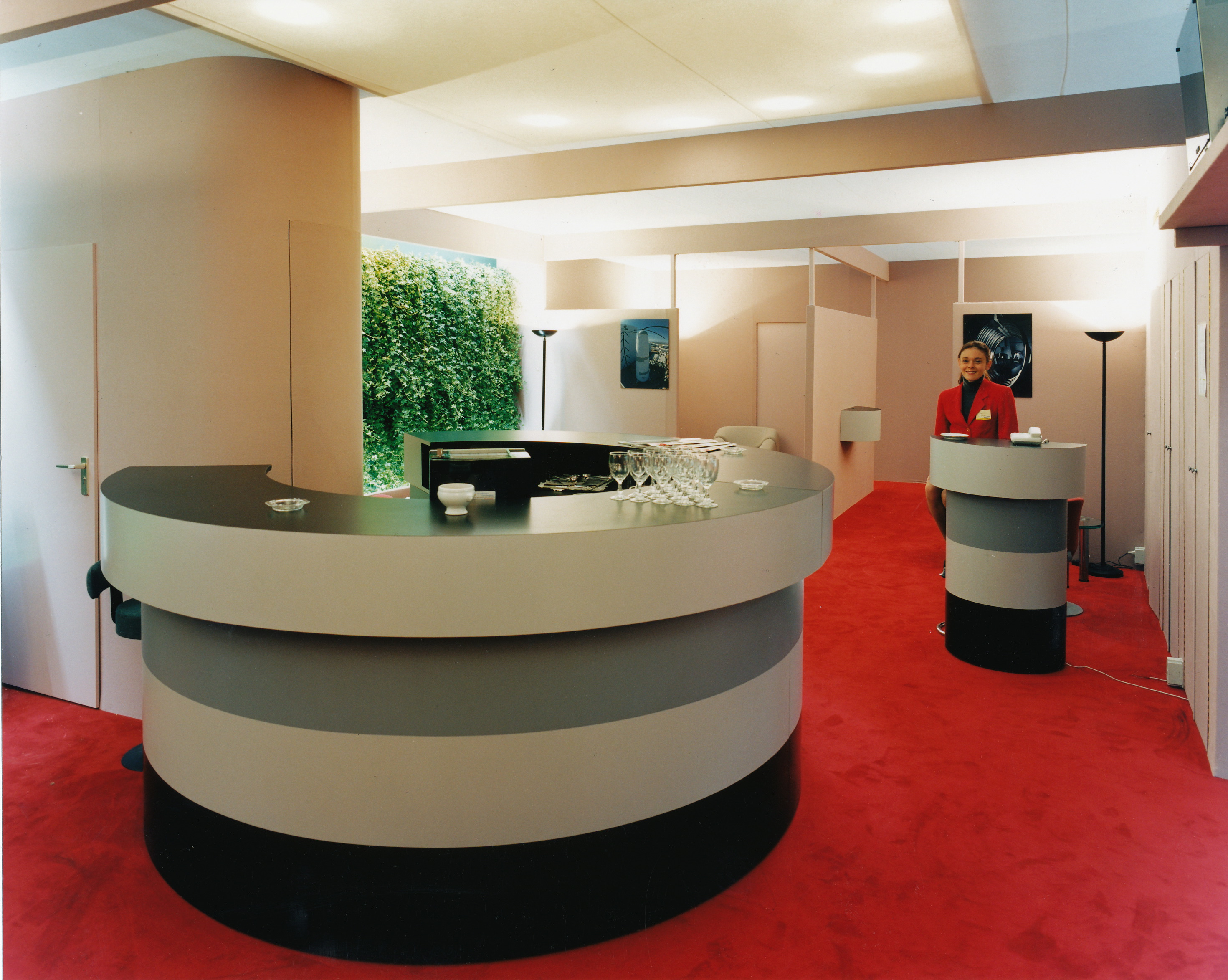
Other variations of the reception area adhered to the original design motif and colors.
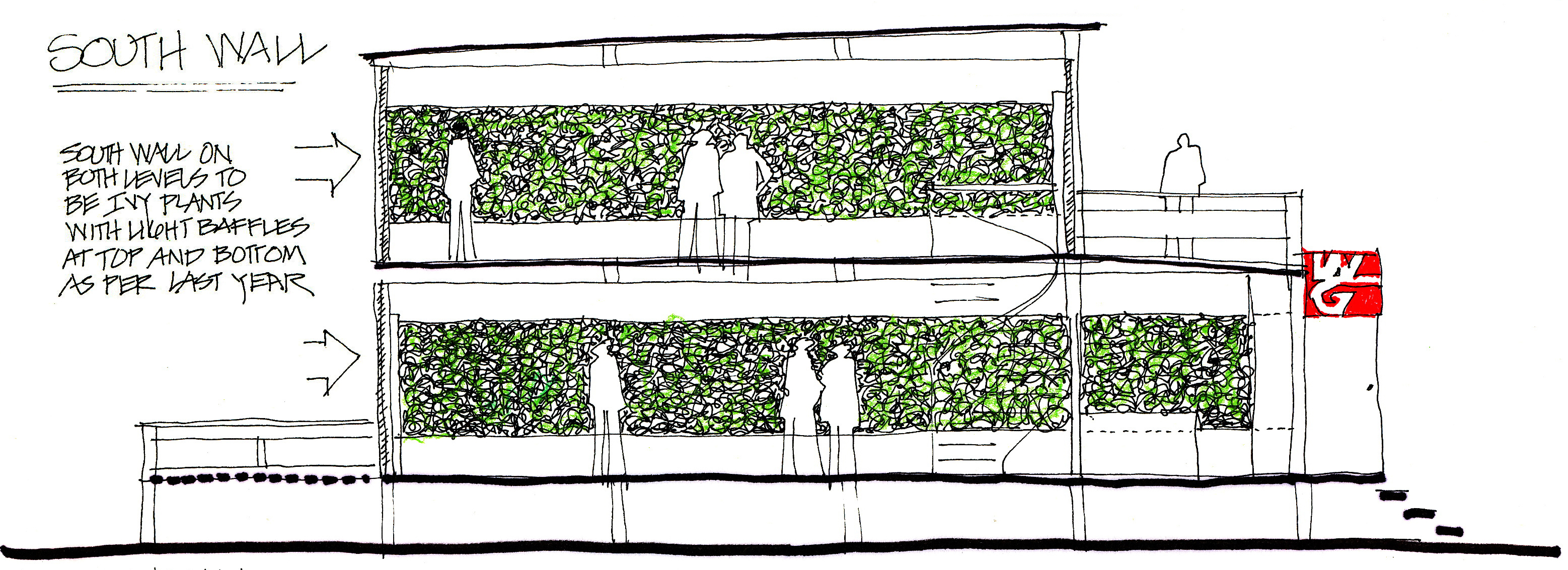
A two story Chalet configuration was used in 1995. The same design motif was used with a proposed mirror wall reflecting the opposite ivy wall. The elevated outdoor deck provided excellent viewing of the show.
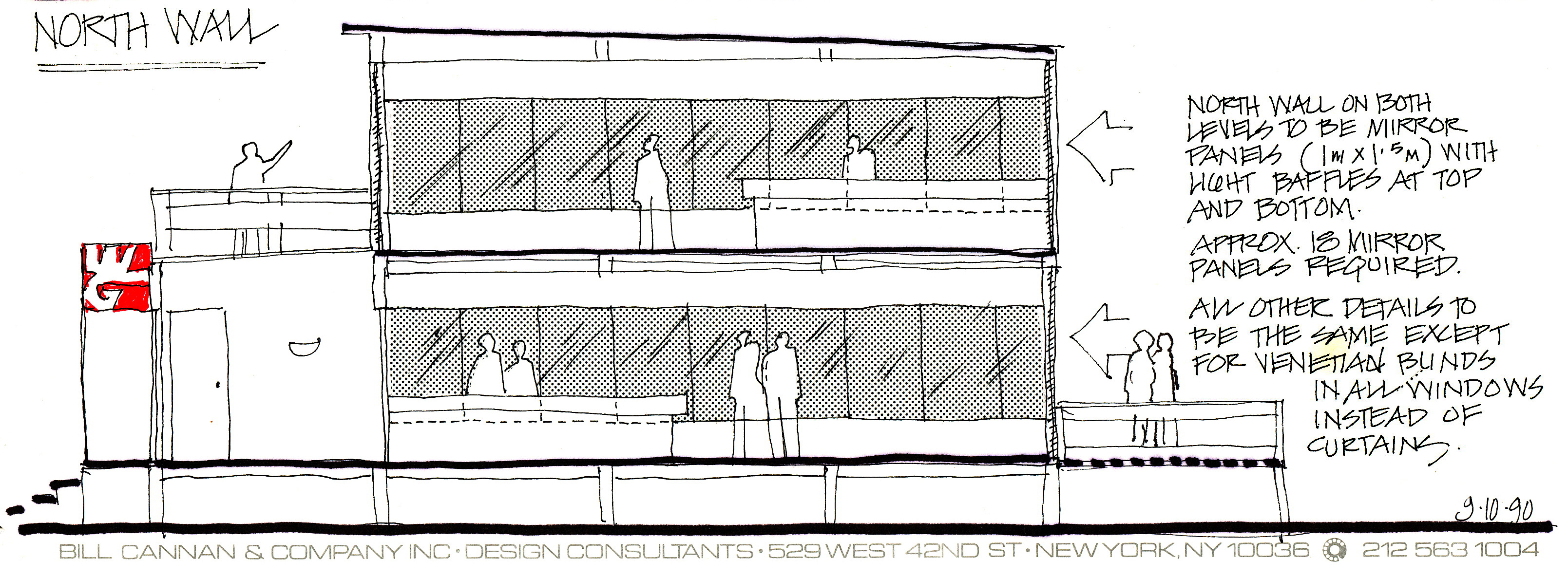
WYMAN-GORDON
EXHIBITS / 1977 - 1981 - 1985 - 1991 - 1995 - 1997 - 1999

Wyman-Gordon participated in their first Paris Air Show in 1977. Over the next twenty years a variety of exhibits were designed to supplement the Chalet experience. These ranged in size from 500 square feet to 2000 square feet.
1977
Wyman-Gordon’s initial exhibit at the Paris Air Show. A steel structure supported over 75 forged products showing their full range of capabilities and experience.
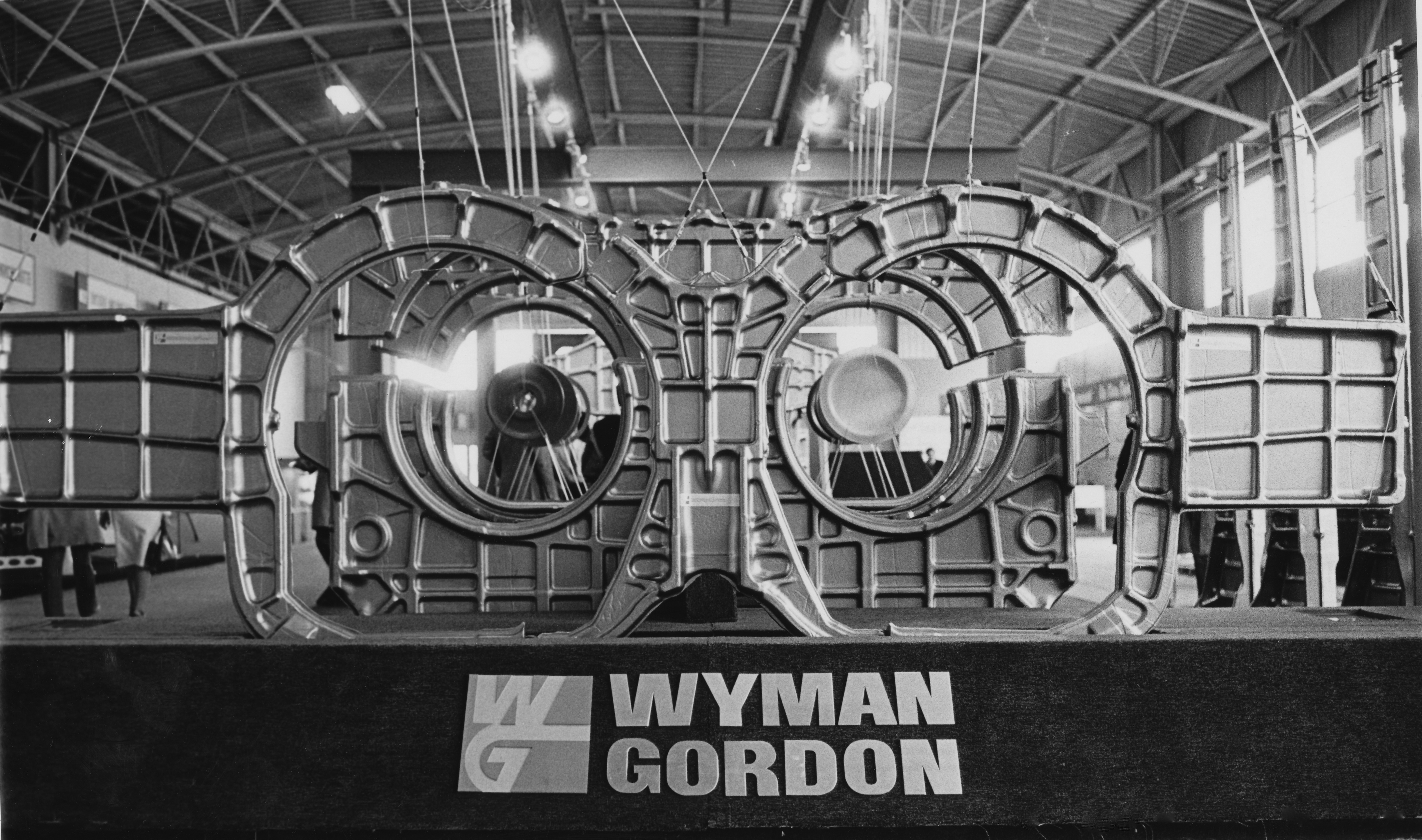
End view of steel structure with suspended Airframes and Turbines.
Wyman-Gordon’s choice to participate with a compilation of large forgings led to a concept of suspending them to create a “factory” atmosphere.
It presented the product at eye level for the exhibitors and visitors benefit. A total of 75 forgings weighing over 35,000 pounds made an impression on most visitors, particularly those from the USSR with their cameras and measuring tapes.
It presented the product at eye level for the exhibitors and visitors benefit. A total of 75 forgings weighing over 35,000 pounds made an impression on most visitors, particularly those from the USSR with their cameras and measuring tapes.

Original concept sketch on flight following 1st meeting at WG plant.
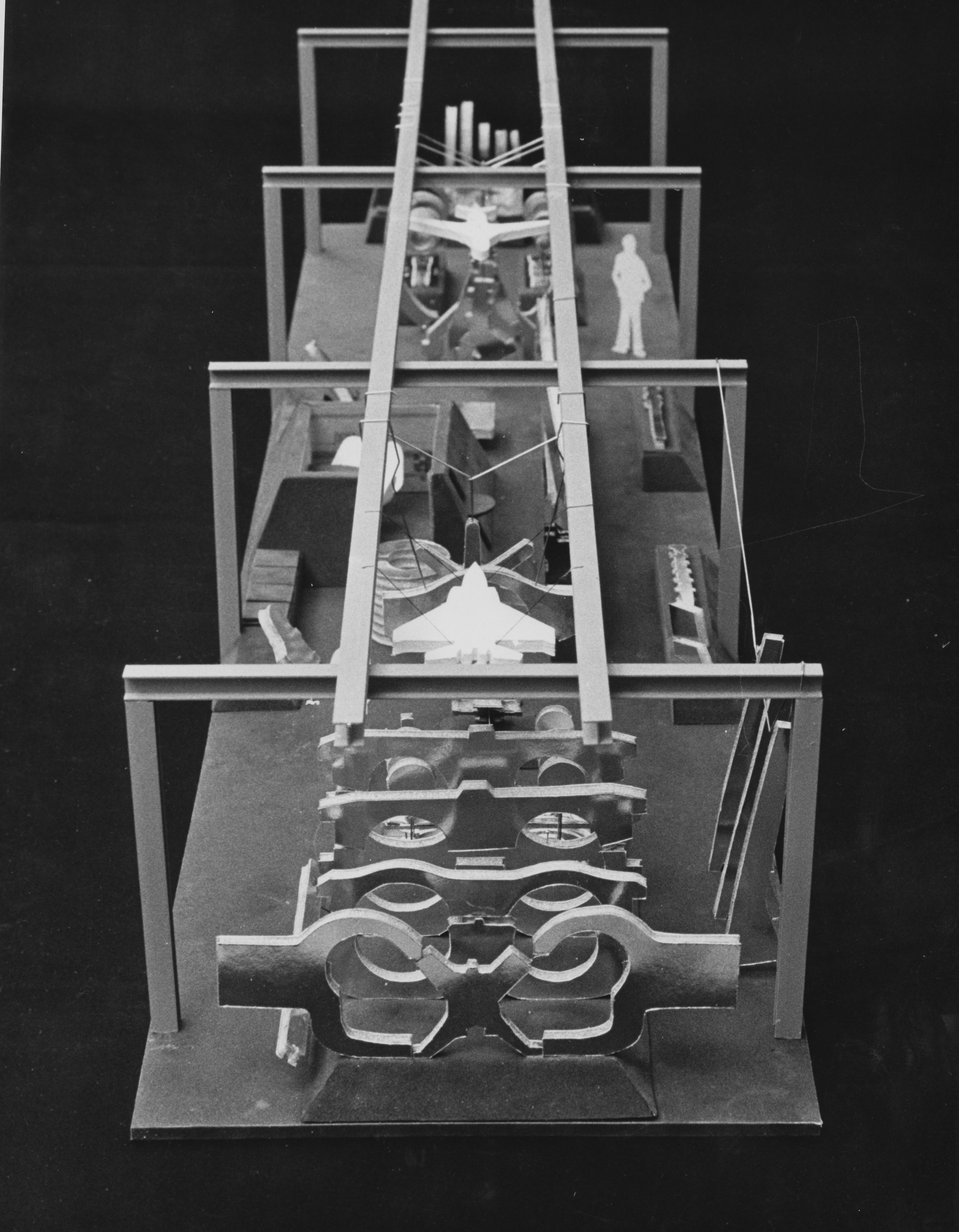
Overhead view of concept model.
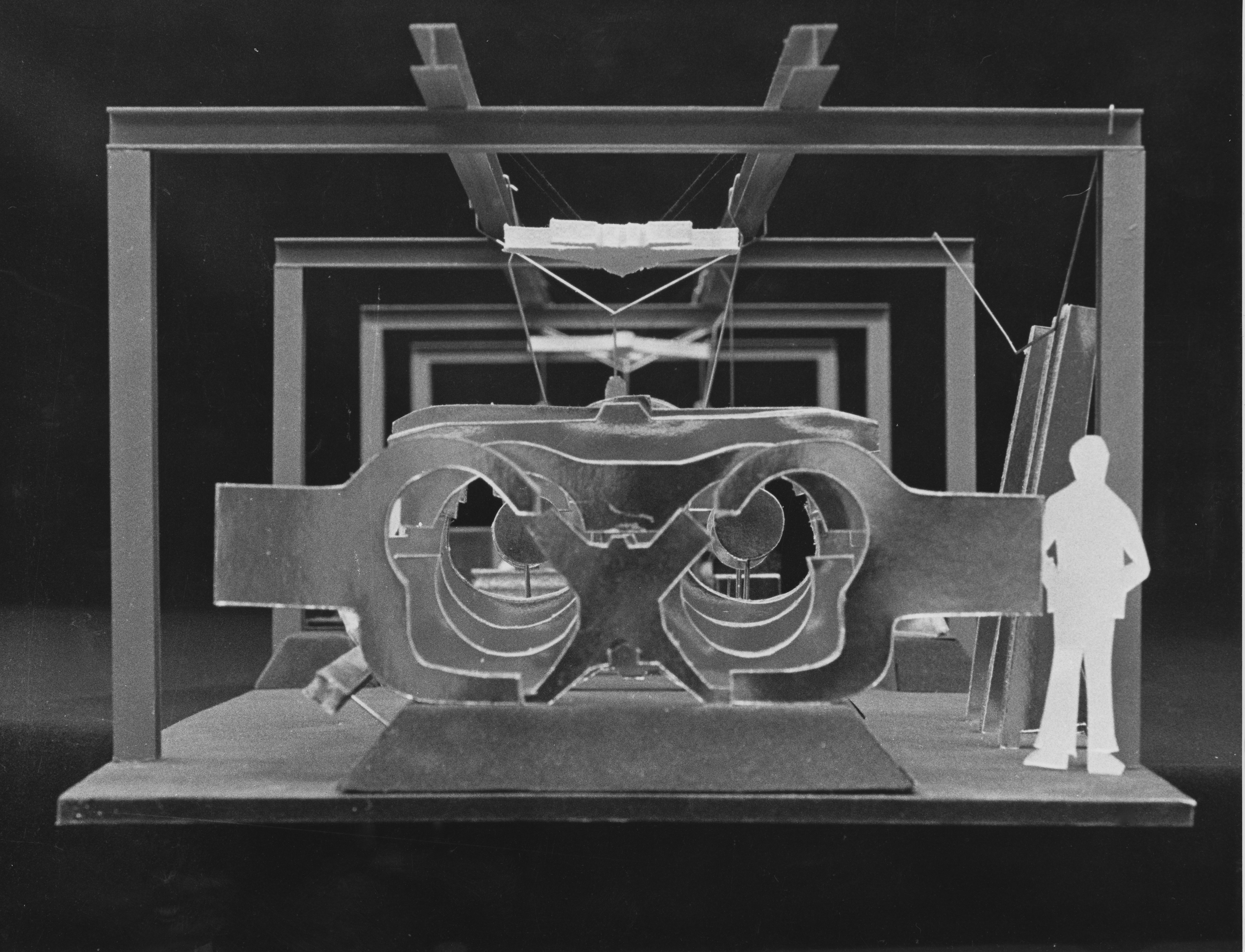
End view of concepts scale model.
(foamcore, paper & acrylic).
(foamcore, paper & acrylic).

Turbine array with bulkheads for F-16
and helicopter rotor hubs.
and helicopter rotor hubs.
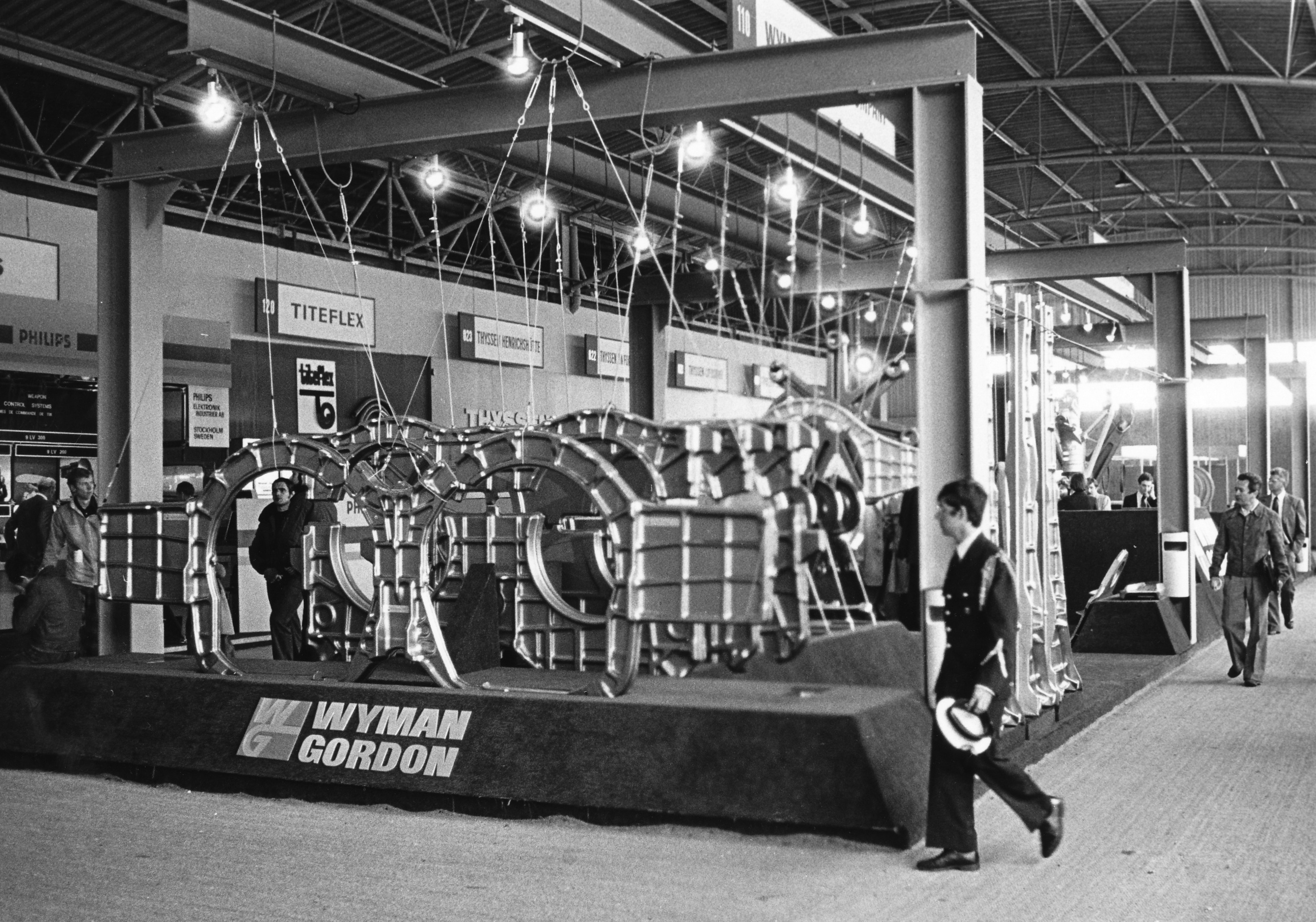
View showing scale of structure and products.
All 12 inch square "I" beams shipped from Italy.
All 12 inch square "I" beams shipped from Italy.
"In the area of metal forming, the winning cup in uncontestably Wyman-Gordon's." AIR & COSMOS Magazine
1981
Wyman-Gordon's exhibit showcasing industry leading capabilities producing discs for all major manufacturers of aircraft engines.

Overview of Gas Turbine display in the International Exhibit Hall. A total of 55 turbine discs and rings were on display.
Referred to as the “Rings Show” this 1800 sf exhibit highlighted Wyman-Gordon’s extensive capabilities and experience in producing Gas Turbine discs of varying sizes and materials.
A total of 55 products were displayed including a graphic of W-G’s 50,000 ton press and the worlds largest forging at that time, the main landing gear support beam for the Boeing 747. Each segment of the display provided direct reference
to a product and product data. The exhibit
included a small private Conference and Meeting area for on-site gatherings.
A total of 55 products were displayed including a graphic of W-G’s 50,000 ton press and the worlds largest forging at that time, the main landing gear support beam for the Boeing 747. Each segment of the display provided direct reference
to a product and product data. The exhibit
included a small private Conference and Meeting area for on-site gatherings.
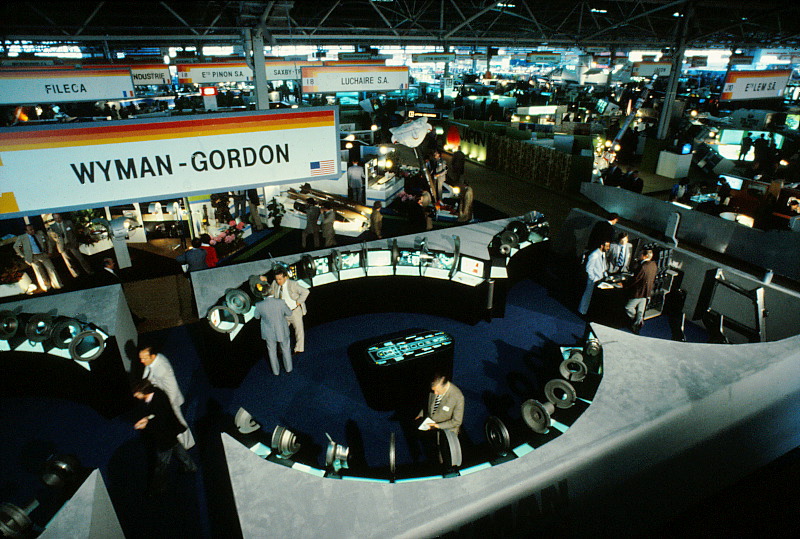
Overview showing 50 ton press graphic, 747 Landing Gear Support beam and more Gas Turbine displays.
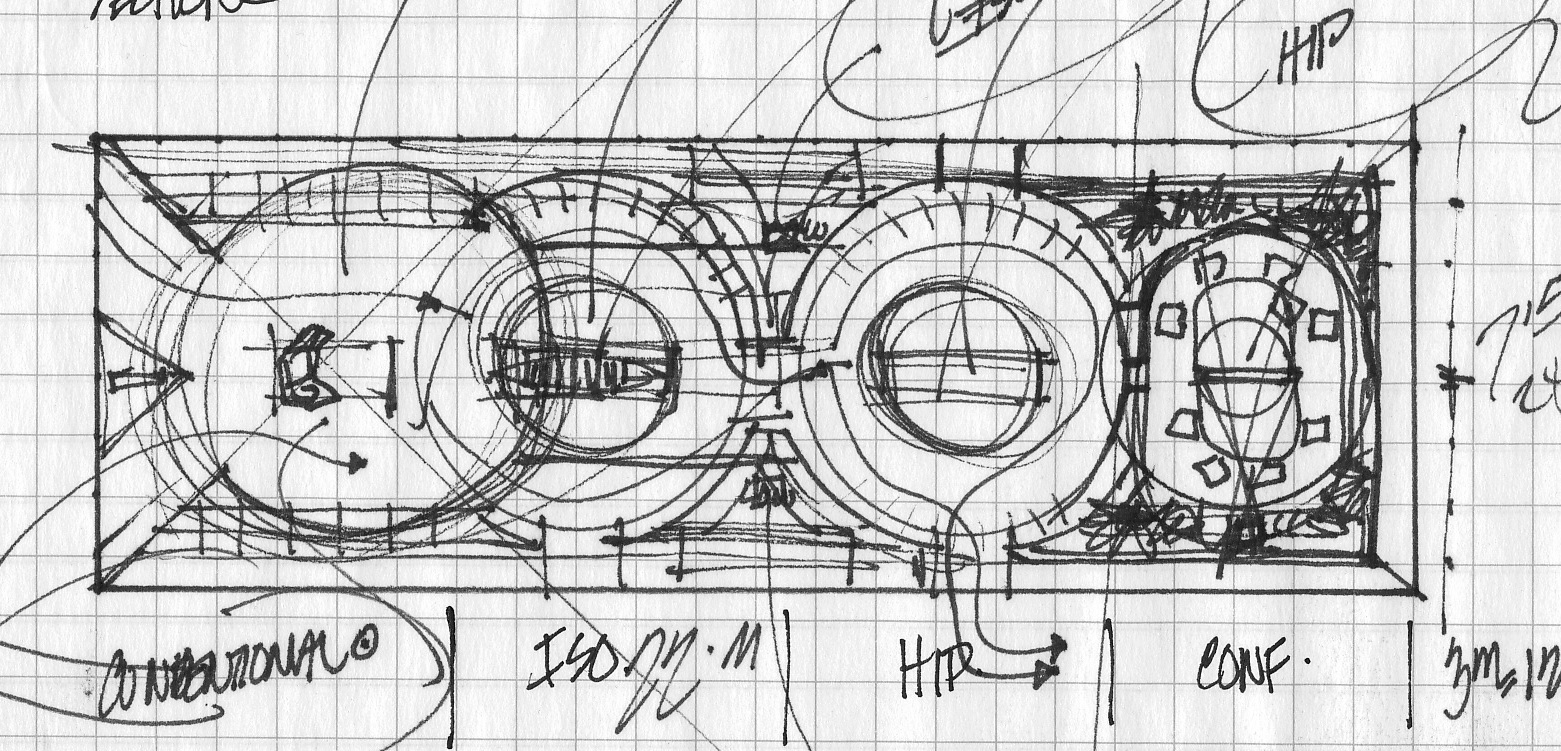
Initial concept sketch for combining Office, Turbines, Press model and 747 support beam areas.
Scale model (1/2' = 1') for client presentation.
Foamcore, paper, and acrylic.
Foamcore, paper, and acrylic.

Pre-fabricated sections of the exhibit were built in Italy and shipped to Paris. The bermed structure was
instrumental in adding crowd control.
instrumental in adding crowd control.

Initial concept sketch for configuration of exhibit and functions set in four display areas.
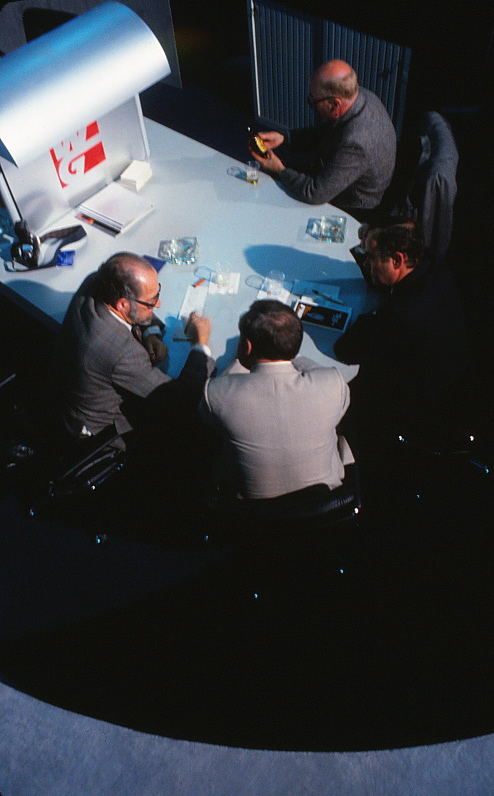
A view of the compact meeting area for 6.

The defined space improved client to client focus.
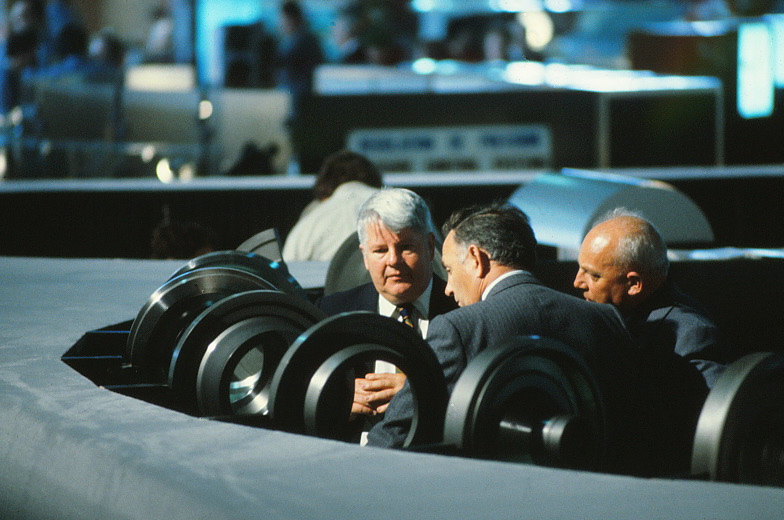
Each product niche displayed back-lit product information regarding material, weight, use, and other specifications.

Special mounts held all products securely in place.
1985
Wyman-Gordon decided to show no products and focus on a Chalet.
A limited exhibit highlight's W-G's capabilities using graphics & photos.
A limited exhibit highlight's W-G's capabilities using graphics & photos.
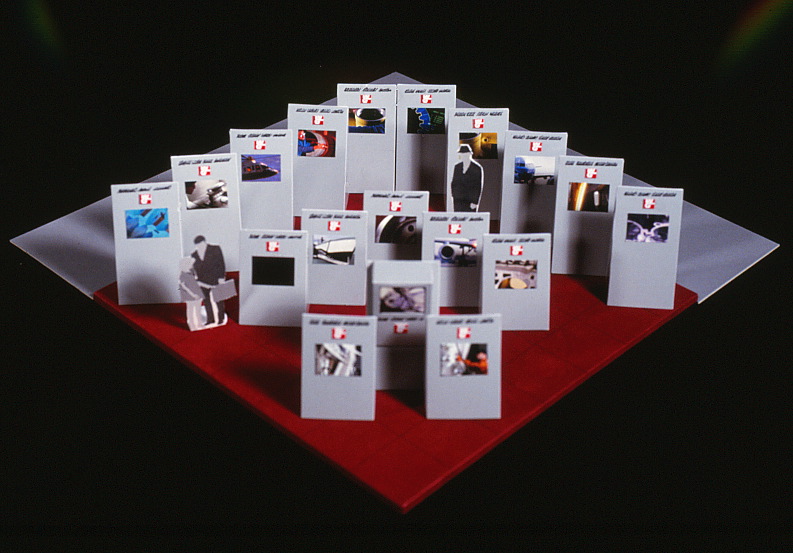
A 1/2" scale model used for client presentation and approval.
(foamcore, paper, and acrylic)
(foamcore, paper, and acrylic)
Wyman-Gordon's first experience with a "Chalet"
was a resounding succes
and established an identity
for future appearances at
the Paris Air Show.
To meet PAS requirements,
a small 550sf exhibit was designed for the International Exhibit Hall. Consisting of 18 display units, each unit illustrated specific Wyman-Gordon specialities and their "Approach to Aeroeconomics."
was a resounding succes
and established an identity
for future appearances at
the Paris Air Show.
To meet PAS requirements,
a small 550sf exhibit was designed for the International Exhibit Hall. Consisting of 18 display units, each unit illustrated specific Wyman-Gordon specialities and their "Approach to Aeroeconomics."
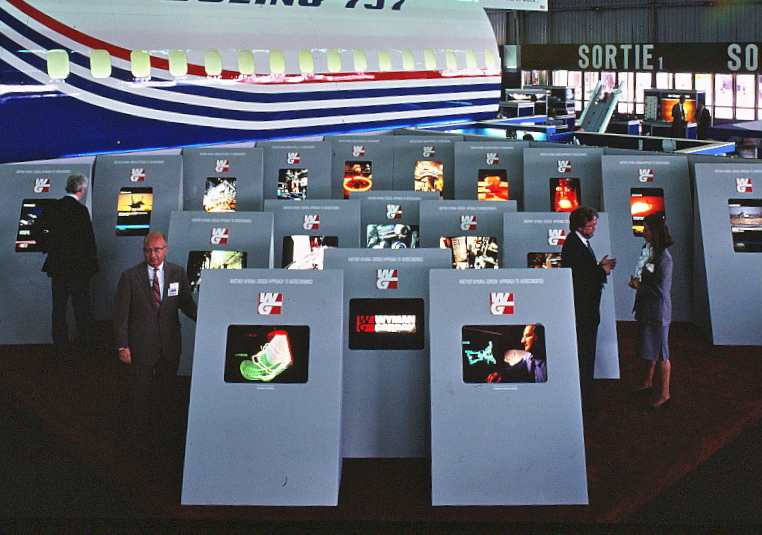
Layout of 18 individual "Aeroeconomics" light
boxes in the International Exhibits Hall.
boxes in the International Exhibits Hall.
1987
Wyman-Gordon’s Exhibit focused on the scope of their experience with titanium, from raw materials to the finished product.

Referred to as “The TI Show,” the exhibit highlighted the full extent of Wyman-Gordon’s capabilities in Titanium. The periodic table symbol for Titanium (TI) was a focal point in the design development of the exhibit.
This year was Wyman-Gordon’s first venture in taking a double “Chalet” on Flight Line B. It offered Bar / Buffet services, for all client meetings, press conferences and a deck for viewing the daily flight demonstrations.
This year was Wyman-Gordon’s first venture in taking a double “Chalet” on Flight Line B. It offered Bar / Buffet services, for all client meetings, press conferences and a deck for viewing the daily flight demonstrations.
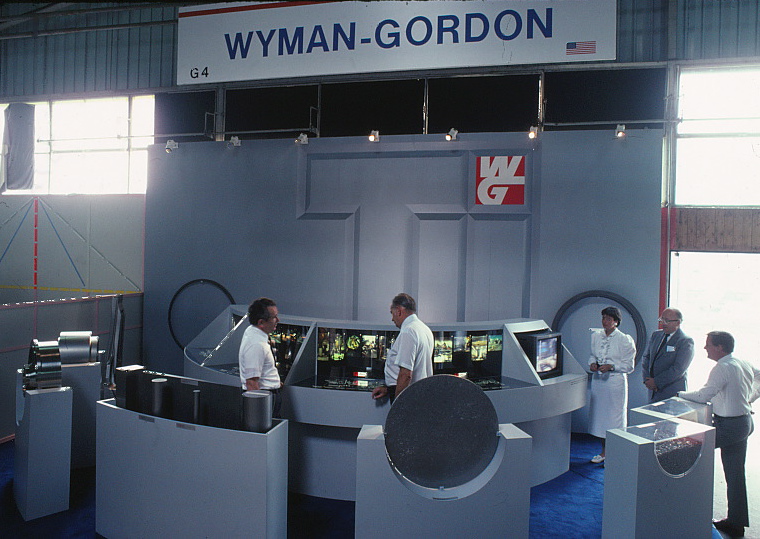
The design scheme was accepted following presentation of these sketches and a 1/2 inch scale model (foamcore, paper & acrylic).
Fabricated in Italy, the 10 exhibit components were easy to
set up and more than met the expectations of the client.
set up and more than met the expectations of the client.

Exhibit plan showing five product displays,
graphic modules and office.
graphic modules and office.
The 450 square foot exhibit was located in the International Exhibit Hall. In order to have a Chalet, exhibitors are required to have an exhibit in one of the International Halls.
Focusing on Titanium, graphic data was supported by actual product in the five sequential categories determined by the Client. They were as follows:
Focusing on Titanium, graphic data was supported by actual product in the five sequential categories determined by the Client. They were as follows:
1. RUTILE GROUP
2. SPONGE GROUP
3. INGOT GROUP
4. BILLET GROUP
5. FORGING GROUP
2. SPONGE GROUP
3. INGOT GROUP
4. BILLET GROUP
5. FORGING GROUP
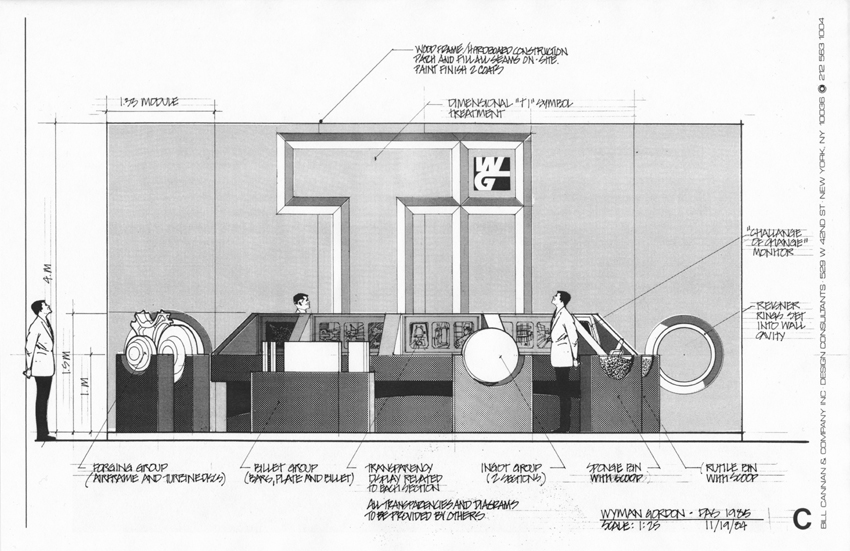
Exhibit elevation with dominant and dimensional TI symbol.
Free-standing Individual display units held actual samples of each of the five Groups.
This allowed a sequential inspection of all five elements - from the raw material to the actual finished product.
This allowed a sequential inspection of all five elements - from the raw material to the actual finished product.

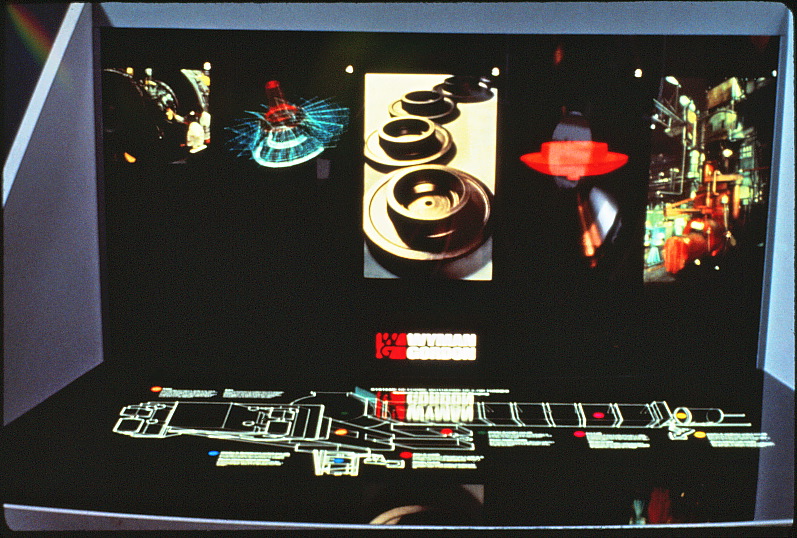
Each of the five modules were dedicated to each of the five Groups. Specific information of each Group included photos, charts and statistical information.
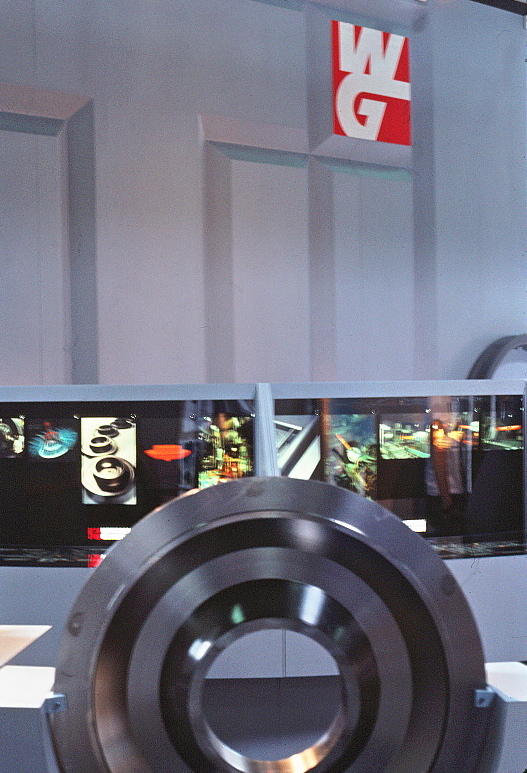
The radial layout of the exhibit concept was designed to align each of the free-standing display elements with the matching graphic wall set behind it.
Behind the wall was a small meeting area for personnel and visitors.
Behind the wall was a small meeting area for personnel and visitors.
1991
Wyman-Gordon's Chalet focused on marketing, sales, and reinforced contacts with their worldwide customers. No products were shown.
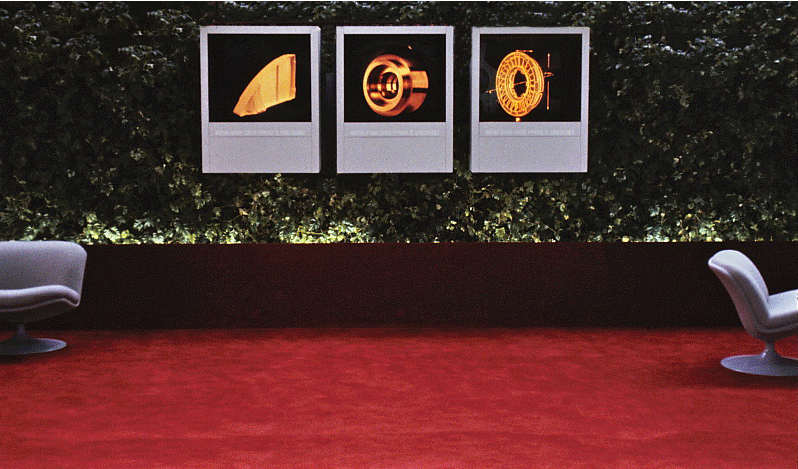
Animated "Magic Mirror" light box presentations showing "as forged" unit dissolving into the "ready to install" unit. Running on a continuous loop, it illustrated one airframe component and two turbines.
With the emphasis on the Chalet, Wyman-Gordon's lightbox display met the Paris Air Show's requirement for participating with an exhibit inside the International
Exhibit Hall.
The ancillary benefit to Wyman-Gordon was the rest area it provided for visitors and exhibitors.
Exhibit Hall.
The ancillary benefit to Wyman-Gordon was the rest area it provided for visitors and exhibitors.
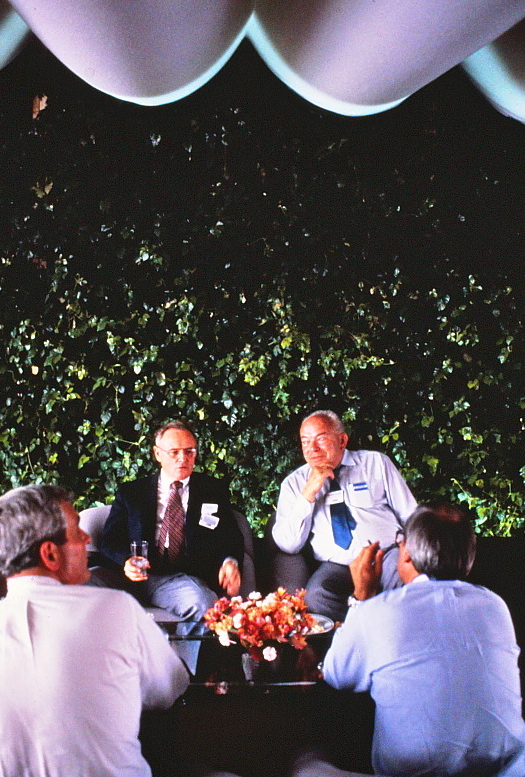
The relaxed environment of the Chalet led to many impromptu meetings.
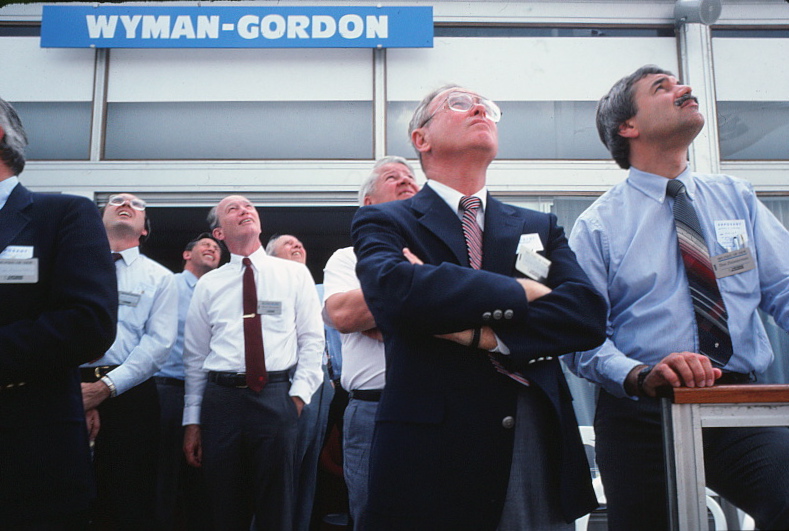
Sales and marketing efforts were conducted in a multi-level Chalet accomodating lunches and client meetings. It also offered prime views of the daily flight demonstrations.
1995
Wyman-Gordon’s Exhibit featured Turbine and Airframe forgings for the Lockheed/Boeing F-22 Joint Strike Fighter.
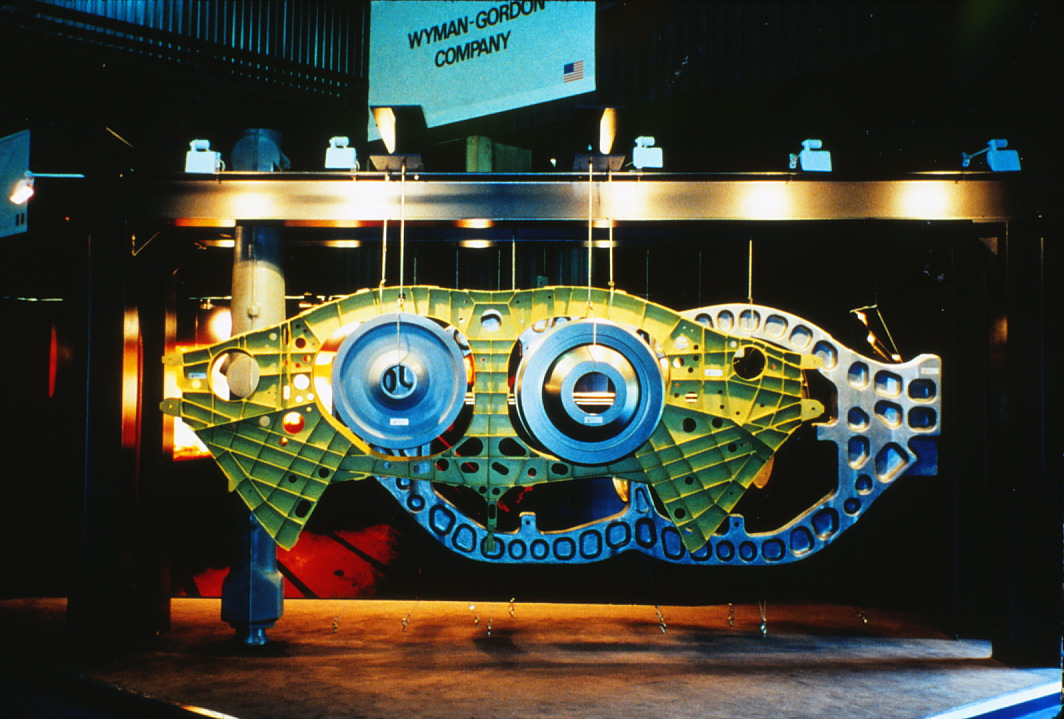
Combined Airframe and Turbine display for F-22 components.
This minimal 550sf exhibit stand focused on airframe bulkheads showing “as forged” and “ready to install” components.
In 1977, WYMAN-GORDON’s investment in a steel I beam structure capable of supporting a number of heavy forgings proved to be a wise decision. Its re-use in subsequent shows provided maximum flexibility in displaying products.
A double-decker Chalet on the Flight Line served as the main Reception area accommodating client meetings, press conferences and lunches.
In 1977, WYMAN-GORDON’s investment in a steel I beam structure capable of supporting a number of heavy forgings proved to be a wise decision. Its re-use in subsequent shows provided maximum flexibility in displaying products.
A double-decker Chalet on the Flight Line served as the main Reception area accommodating client meetings, press conferences and lunches.
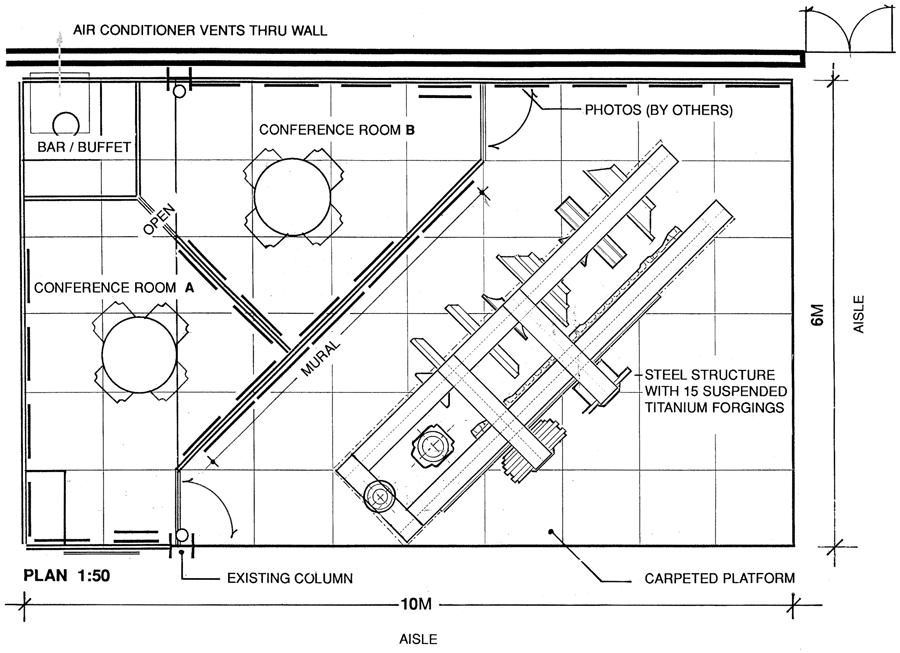
Floor Plan
The design challenge was to fit 15 forgings and its supporting structure, two meeting rooms and bar/buffet service into a confined space.
The design challenge was to fit 15 forgings and its supporting structure, two meeting rooms and bar/buffet service into a confined space.

Presentation sketch of “as forged” and “ready to install” bulkheads for the F-22 and a 747 landing gear. This was the third re-use of the original I beam structure.
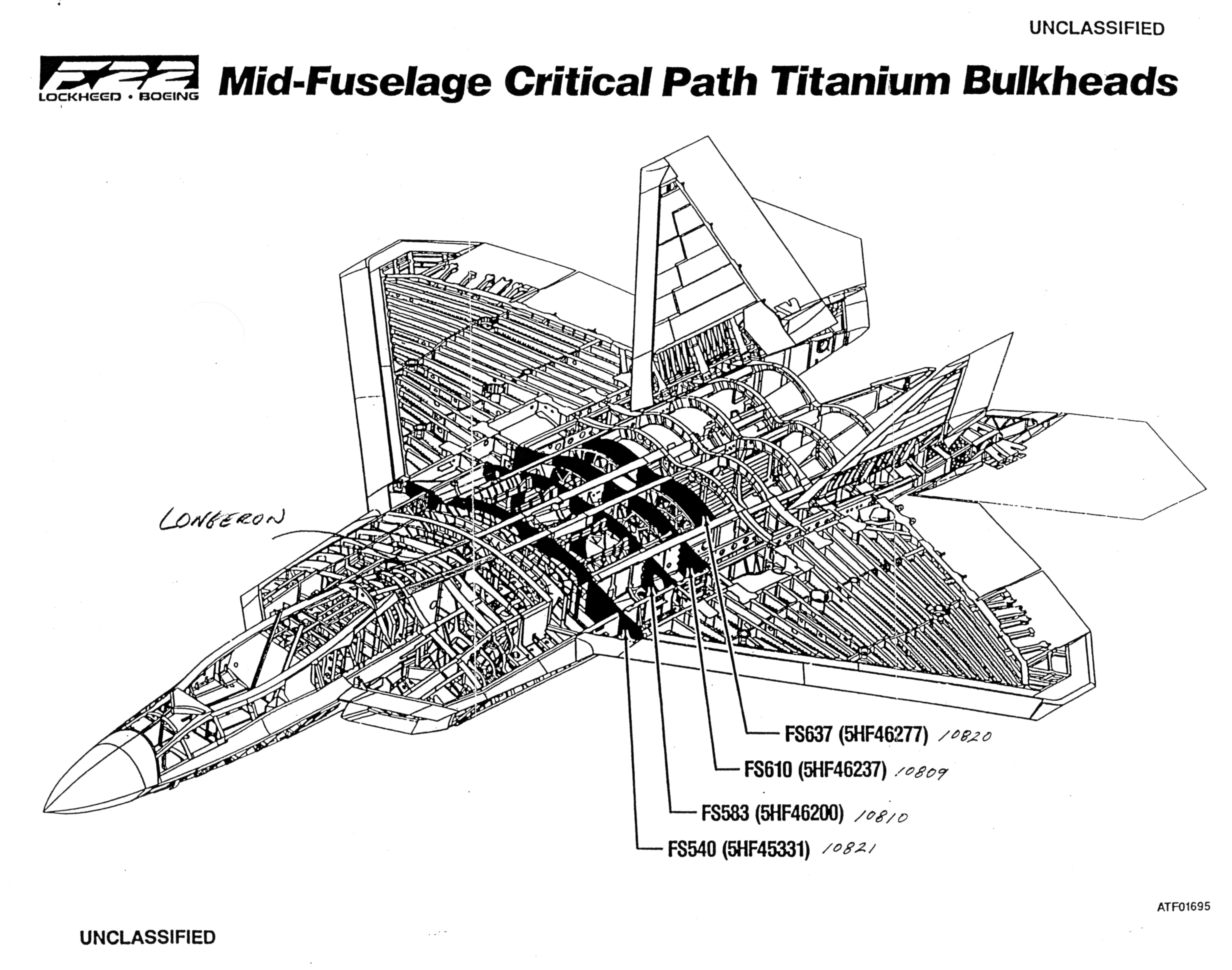
The F-22 engineering drawing showing bulkhead locations in the
aircraft's structure.
aircraft's structure.
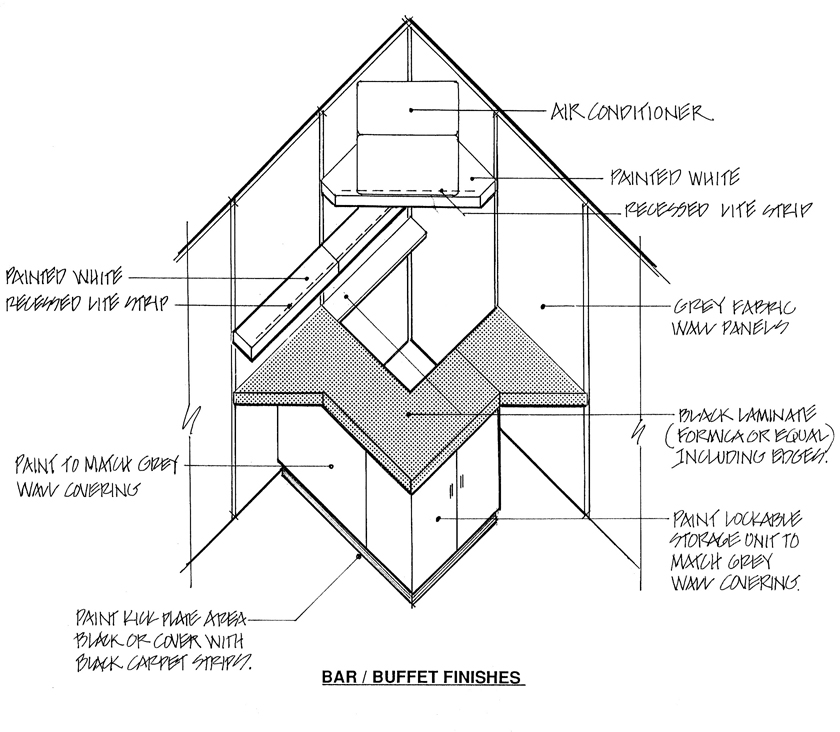
The compact bar/buffet structure accommodated an air-conditioner + 2 refrigerators + 2 storage units + lighting + shelving.
“An amazingly efficient utilization of space”
according to one
W-G executive.
according to one
W-G executive.
1997
Wyman-Gordon’s Exhibit featured Turbine and Airframe forgings, castings, extrusions, powder metallurgy, process control and
quality assurance.
quality assurance.
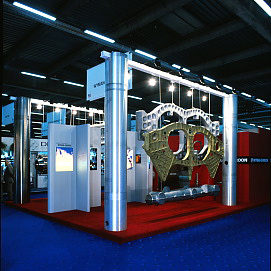
Airframe display with two F-22 bulkheads (before and after machining) and a forged 747 landing gear.
Another use of the steel I beam structure.
Another use of the steel I beam structure.
The 42nd Paris Air Show marked the 10th time that W-G exhibited at the world’s largest and best attended Air Show. This exhibit, their largest in the International Exhibit Hall featured two steel structures focusing on the two major capabilities of Wyman-Gordon, forged Airframe components and Turbine discs and rings.
The other half of the 1200sf space was for two reception areas, two conference areas and a combined bar/buffet area.
The other half of the 1200sf space was for two reception areas, two conference areas and a combined bar/buffet area.

Turbine display with a variety of turbines and airframe components. Vertical pylons support graphics and data.
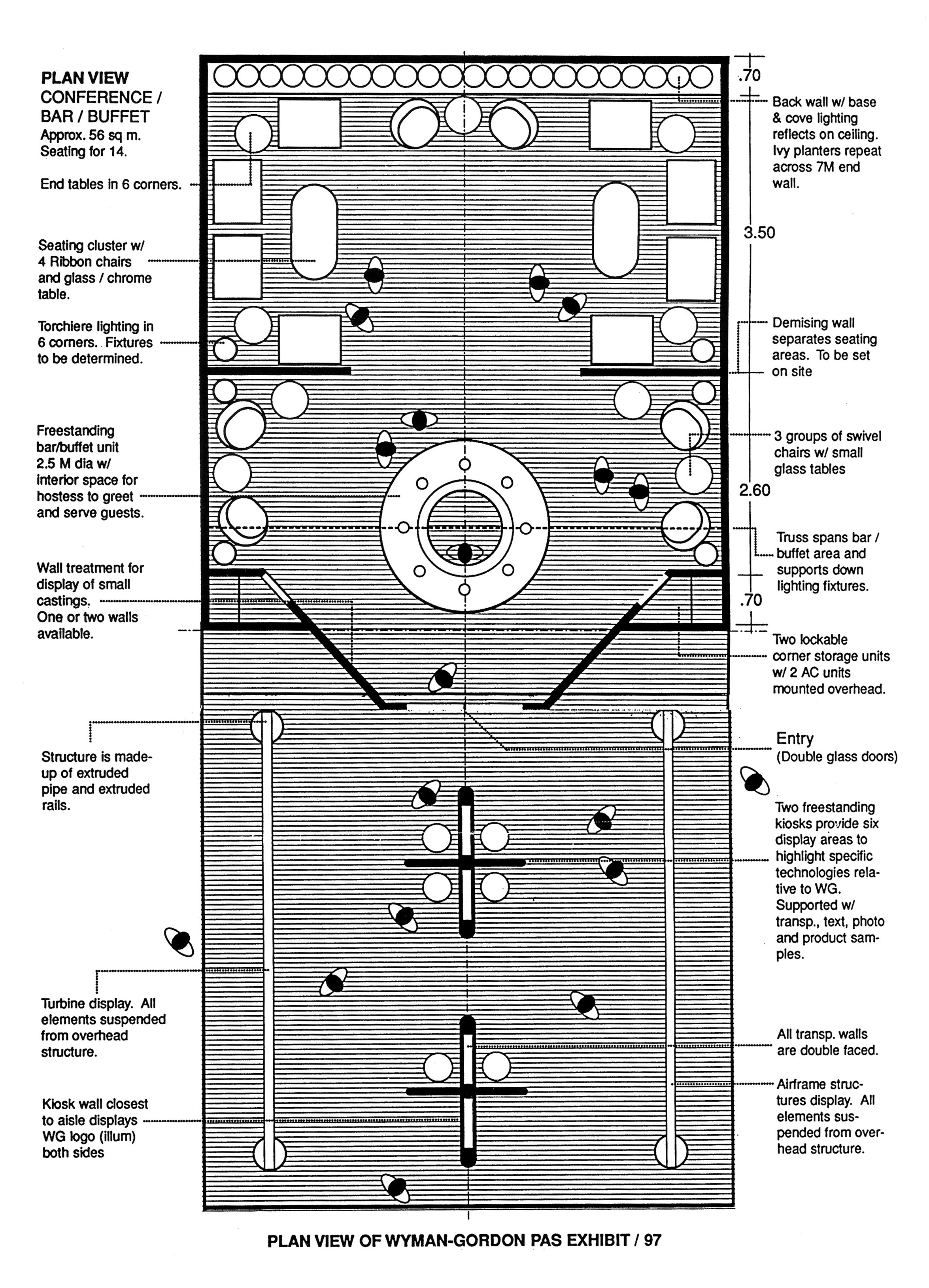
The 1200sf area successfully integrated
Exhibit + Hospitality + Meetings.
Exhibit + Hospitality + Meetings.
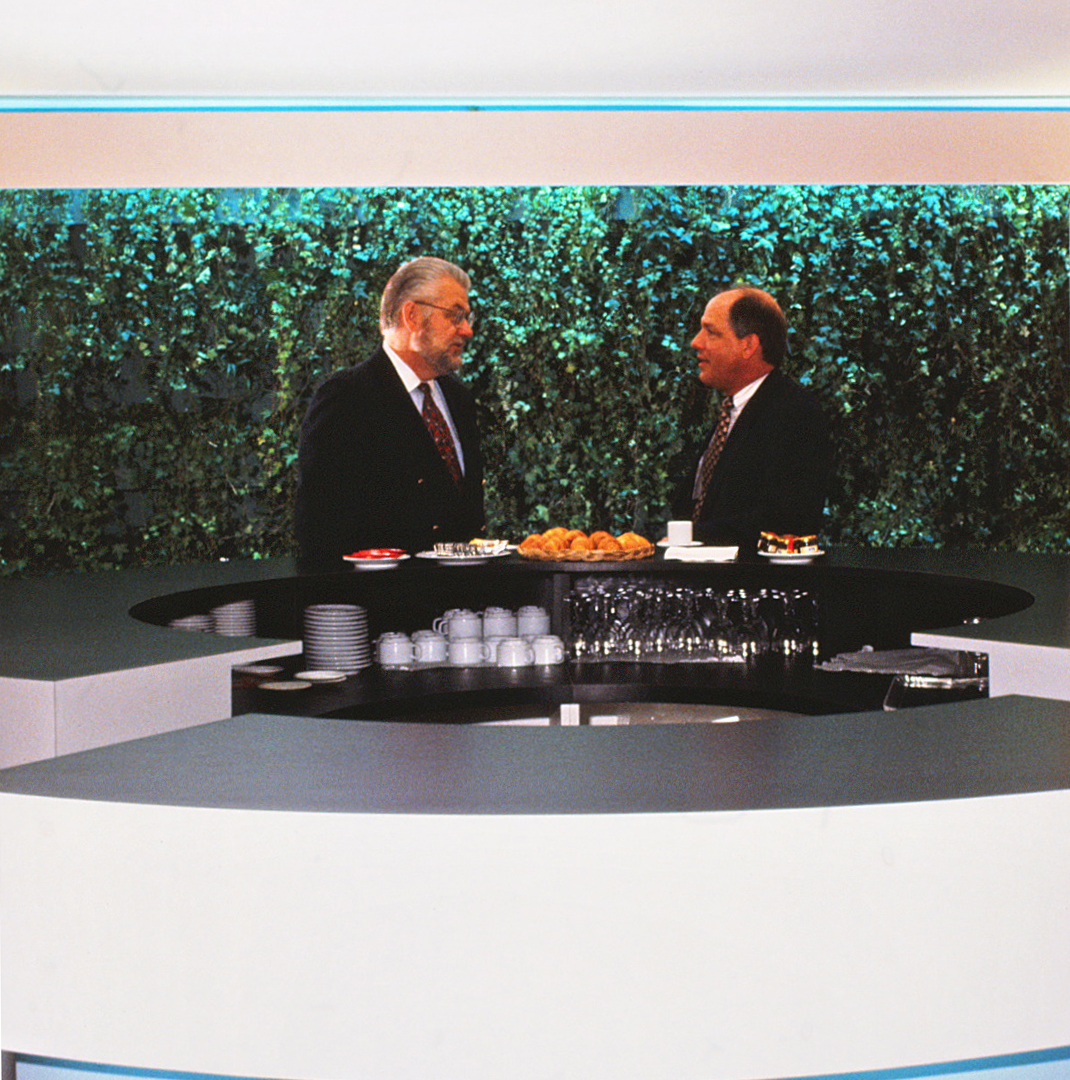
Privacy for meetings in the two
separate conference areas.
separate conference areas.
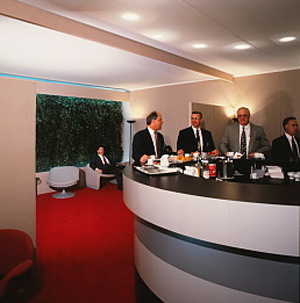
A combination of bar and food service
in the reception area.
in the reception area.
WYMAN-GORDON was acquired by Precision Cast Parts in 2000.
Their new management decided to forego participating in Air Shows.
This brought to an end a 20 year run of one of my favorite
projects for one of my favorite clients.
Their new management decided to forego participating in Air Shows.
This brought to an end a 20 year run of one of my favorite
projects for one of my favorite clients.